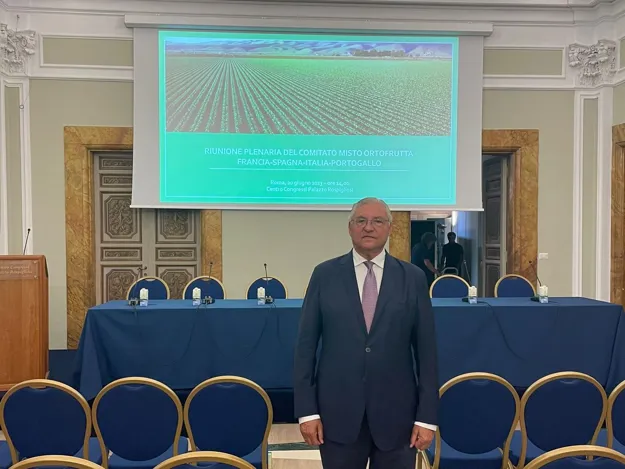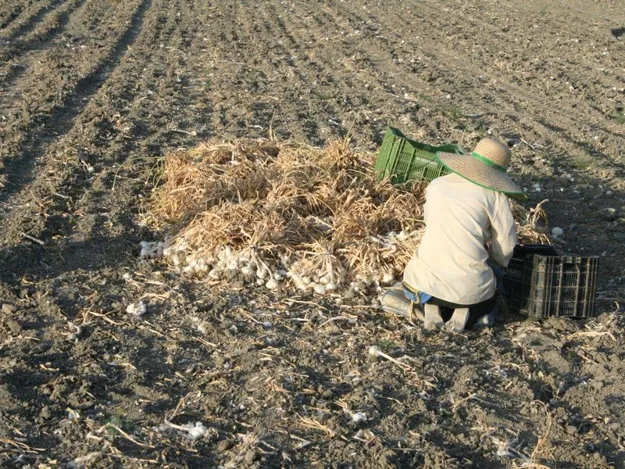The Government of Andalusia recently published data about the 2023/24 garlic campaign in Andalusia, thereby highlighting the difficulties that producers are facing this year, especially when it comes to the impact of drought, which is taking a toll on all campaigns in the region. It has caused the production area to be reduced by 37.8% compared to last year, and due to the lower yields caused by water stress in the plantations, the production has fallen by 45.5%.
"From the beginning, there has been great uncertainty due to the drought, which has caused many garlic growers to stop planting because they were not sure if they'd have enough water to irrigate their crops," says Miguel del Pino, president of the garlic sector at Asaja. "Garlic does not need a lot of water, but it does need irrigation at very specific times, and failing to do so can entail significant production losses."

Miguel del Pino at the Plenary in Rome of the Joint Fruit and Vegetable Committee of Spain, France, Italy and Portugal.
"The average cost of planting a hectare of garlic ranges between 12,000 and 13,000 Euro, and we must take into account that, because of the crop's characteristics, growers plant areas of 20 hectares or more, so many have not wanted to risk losing that amount of money."
"However, the reality is that everyone has been affected by the drought; even those who had water. Some plantations have lost it all, but those that have been lucky enough to have production have fortunately obtained good quality garlic, as when the rains came, 90% of the Andalusian garlic was already in the warehouses. This wasn't the case in Castile-La Mancha and the rest of Spain, where the quality of the harvest has been disastrous."
"Consequently, the harvest in Andalusia has been lower than expected, but prices have been higher than last year. Thanks to this, whoever has had a good harvest is going to earn quite a lot of money this year, and those who have lost some volumes will manage to recover some of the losses."

In any case, if we are talking about prices, there is something we should clarify to prevent consumers from buying into wrong discourses, says Miguel. "Garlic consumption in Spain and Europe does not reach 2 kilos per person per year on average. Right now, garlic costs 5 Euro per kilo, so, on average, a consumer can eat garlic throughout the year for just 10 Euro."
"In fact, I always joke that the expense of eating garlic is equivalent to a person drinking one coffee a month. With this I want to make a plea for people not to be surprised that garlic costs money; and in fact, even if it cost twice or three times as much, they wouldn't notice it in their economy either, according to consumption statistics. For us, however, it would be very important to get that increase, because we cannot forget that garlic is a crop that helps keep the population in rural areas, generating work not only in the harvest, but also in the stores, which operate almost all year round. That is why we are fighting with the supermarkets, because a price increase would help us protect this sector, which contributes so much to society."
What are the prospects for the next season?
The question now, at this time when producers in all garlic growing regions in the country report bittersweet results, is what is going to happen in the next planting season.
"It is still too early to give a figure, but another significant reduction in the acreage is expected," said Miguel del Pino. "Now it is time to get the lands ready to sow the early garlic, and only those that are guaranteed to have enough water will risk doing so."
"I estimate that only between 20-30% of producers have already leased lands to produce garlic, and the rest are still looking for farms with wells to help them salvage the campaign. Here in Cordoba, unfortunately, there is a great shortage of water and this year people are again looking to Castile-La Mancha, mainly to the province of Ciudad Real, as an alternative; but also to the Antequera area, where there is also a greater amount of groundwater."
For more information:
Miguel del Pino
President of the garlic sector, ASAJA
migeldelpinonieto@gmail.com
